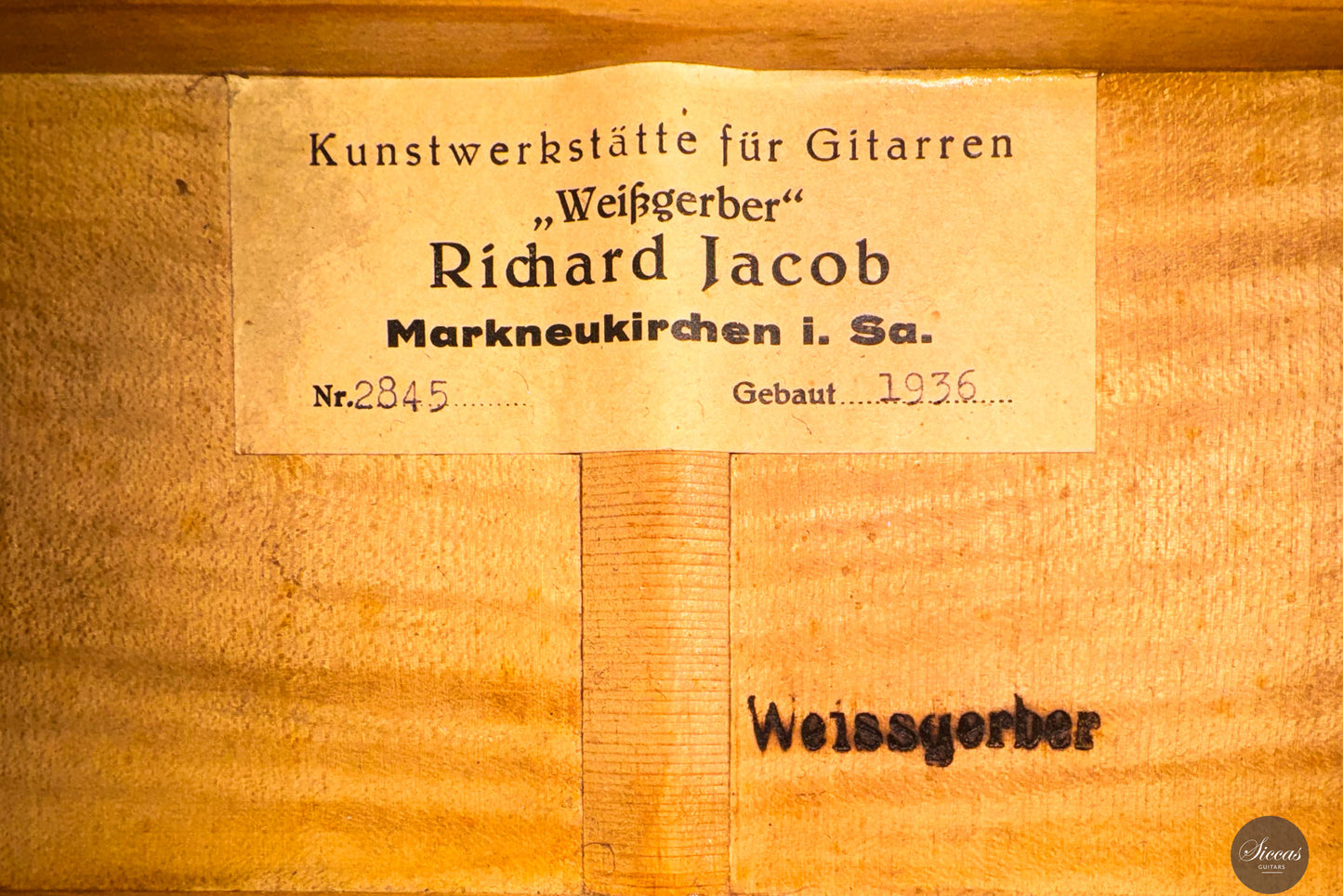Richard Jacob Weissgerber - 1936 - Torres / Simplicio - 64 cm
Richard Jacob Weissgerber - 1936 - Torres / Simplicio - 64 cm
Details
Details
Overview
Overview
Shipping important note
Shipping important note
Delivery times are typically reliable and most instruments arrive within the estimated timeframe.
Should any unexpected delay occur, our team will keep you informed and provide support at every step. For all shipping details and exceptions, please see our Shipping Policy.
Details about GPSR
Details about GPSR

























Video overview


More details about the guitar
About the luthier
Richard Jacob Weissgerber was one of the most prolific and versatile German luthiers of the 20th century. His artistic creativity and meticulous craftsmanship resulted in an impressive output of around 3500 instruments, making him one of the most significant figures of his era. His guitars are renowned for their individuality in both design and construction, combining German precision with tonal qualities that captivated players and collectors alike. Weissgerber’s work reflects a deep understanding of traditional European guitar making, while his unique approach ensured a distinctive voice within the instrument’s history.About the guitar
This Simplicio-inspired model was built in 1936, during the later period of Weissgerber’s career. It illustrates his ability to blend Spanish tonal aesthetics with German craftsmanship. The Spanish guitarist Miguel Llobet once remarked that Weissgerber’s instruments were among the very few German guitars to achieve a truly Spanish sound, a statement that underlines the importance of his work. Characteristic of Weissgerber’s instruments from this time is the distinctive rosette design made of ebony and galalith, arranged in concentric ring patterns. The spruce top is paired with flamed maple back and sides, offering both brightness and depth, while the mahogany neck, stained black, contributes to stability and visual elegance. The headstock is also crafted from mahogany and fitted with a frontal head plate. With its low weight of 1310 grams and air resonance around A to A sharp, this guitar combines quick response with clarity and brightness. The instrument has undergone some repairs on the sides, where braces had once pushed through, yet overall it remains in very good condition. With its Torres- and Simplicio-inspired design and its clear yet lyrical voice, this Weissgerber represents both an important chapter in 20th-century guitar making and a highly desirable instrument for players and collectors.Condition
The guitar is in very good condition, with some side repairs professionally executed. It retains structural stability and musical quality, making it a fine example of Weissgerber’s craftsmanship.Regular care extends the life of the instrument
Even with careful use, a classical guitar may gradually change in appearance or respond to unstable storage conditions. Have a close look at your guitar regularly and be attentif to changes. If your instrument is suffering from its environement, it will let you know.
Protect Your Guitar: Handle with Care
Be mindful when touching your instrument with greasy or unwashed hands: any skin contact is a small attack on the varnish. Of course, a guitar is made to be played, but taking a few precautions helps preserve its beauty: wash your hands before playing, wear long sleeves, and avoid unnecessary direct skin contact with the body of the instrument.
Pro tip: Avoid playing with a button-up shirt, heavy jewelry, or a belt, as these can scratch the guitar. Also, make sure your guitar case is free of any objects that could damage the instrument during storage.
String care
A good habit to adopt is wiping down your strings briefly after each playing session. This small action significantly extends their lifespan and helps maintain a consistent, comfortable feel under your fingers.
Most importantly, clean strings are essential for keeping your instrument in tune. Corrosion, sweat, and dust can affect the uniformity of the strings and interfere with accurate tuning across the entire fingerboard.
Pro tip: If you're having trouble getting your guitar in tune, it might be time to change the strings. A useful test is to compare the pitch of the 12th fret harmonic with the fretted note at the 12th fret; if there's an unusually large gap between them, your strings may have lost their integrity and should be replaced.
Keep Your Shellac Finish Shining!
Got a guitar with a shellac (French polish) finish? Here's a simple trick: Take a clean microfiber cloth and gently breathe on the surface to create a light mist. Then, softly rub to remove fingerprints, sweat, and grease. That’s usually all it takes to keep it looking great, no products needed!
Pro tip: Every few years, treat your guitar to a check-up with a luthier to keep it in top shape.
Storing Your Guitar: Climate Matters
Your guitar can safely stay outside its case, as long as the surrounding environment maintains 42–55% humidity and a temperature between 18–25°C.
Keep in mind that humidity levels can still fluctuate inside the case, especially during seasonal changes.
- Too much humidity may cause overtightened strings and a dull tone.
- Too little humidity can lead to a bulging top, string buzz, or even cracks.
Avoid placing your guitar near radiators, air conditioners, or windows with direct sunlight.
Pro tip: Always close your guitar case while playing. This helps preserve a stable microclimate inside the case, so your instrument is protected the moment you put it back in.





















































